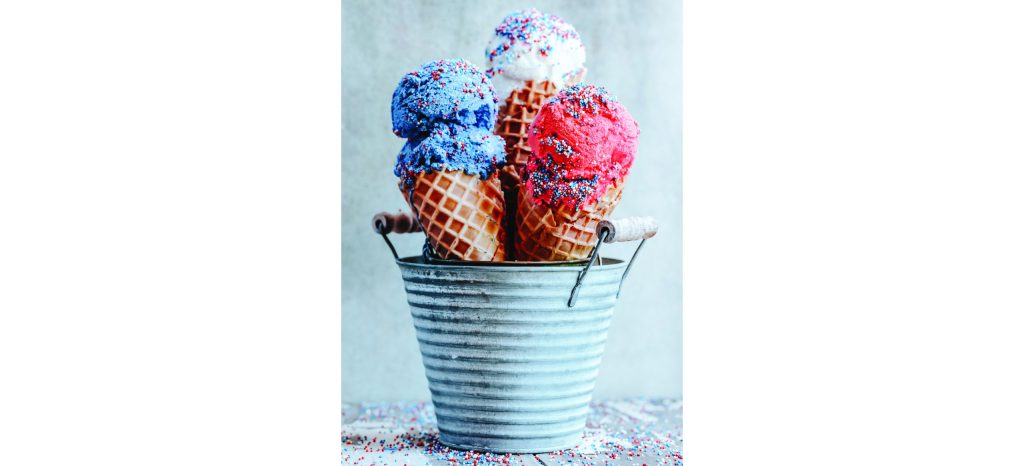Focus on Food

Red, White and Scoop
Homemade ice cream with natural dyes
Story and Photograph by Rose Shewey
America, my sweet home away from home. Thirteen years ago in August, you literally took my breath away when I immigrated via Orlando International Airport and, exiting through the sliding doors of Terminal A, was swallowed up by a thick cloud of heat and humidity that momentarily stopped me in my tracks.
While I have yet to adapt to the climate in the Southeast — a mild day in April resembles an average Central European midsummer day — I have reached expert level in managing sweltering summer heat and refining cool-down techniques. If migrating north between the months of June and October is not an option, the least one can do to survive these long, hot summers is get a season pass for the pool and eat lots, and I mean lots and lots, of ice cream.
In honor and celebration of The Star-Spangled Banner, I am shining the spotlight on food dyes and I’ll let that cat right out of the bag — you do not have to use artificial dyes to achieve stunningly vibrant, saturated colors, in ice cream or any other foods. There are a couple of all-natural brands on the market that produce gorgeous vegetable dyes that will knock your socks off. But do not fret, I have also had great success with some fantastic home-dye options.
Red
Powdered raspberries or strawberries will not just give your creation a beautiful blush color (or light red if you use large quantities), but also add an attractive flavor to your food. Red beet powder (not juice) is a decent colorant, and surprisingly, does not impart the quintessential earthy root vegetable flavor. It does, however, turn slightly more magenta than red, in my experience.
Blue
My favorite blue coloring agent is blue butterfly pea flower. This powder turns into a pastel blue with lavender undertones, but it depends on what you color and how much you use. Blue spirulina is another reliable and potent dyeing agent for a vivid blue color.
Advising on the exact measures is tricky when it comes to natural food dyes. The outcome depends on so many factors, such as the pH level of the food you are dyeing and the freshness of your colorant, to name just two. It takes some experimenting but it is so rewarding to draw from Mother Nature to refine home-crafted treats.
All romantic notions and sweet childhood memories aside, making ice cream is cold, hard science. With commercial ice cream as the gold standard in terms of texture and viscosity, homemade ice cream tends to disappoint (think large, grainy ice crystals), but by understanding the ideal ratio of the basic components of ice cream, as well as inviting all-natural texture boosters into your kitchen, the perfect hand-crafted scoop is well within reach.
Blank Canvas ’n’ Ice Cream
(Makes 1 quart ice cream)
(A basic dairy and egg-free ice cream recipe that can be adapted to any flavor)
4 cups dairy-free milk (see notes)
1/4 cup sweetener (e.g., granulated sugar or honey)
1 teaspoon agar flakes
2 teaspoons tapioca starch
1/2 cup smooth nut butter (e.g., almond butter or coconut manna)
Pinch of salt
1 teaspoon vanilla extract (optional)
In a medium skillet, bring the milk to a boil, whisk in sugar and agar flakes, and simmer for 8-10 minutes. Stir frequently to completely dissolve agar flakes. Meanwhile, prepare a tapioca starch slurry: In a small cup, combine tapioca starch with about 1 tablespoon of cold water and mix well. Turn off heat and whisk tapioca starch slurry into the milk, allowing the residual heat to cook the starch. For best results, add your ice cream base to a blender together with your nut butter, salt and vanilla extract and, if desired, food dye, and process until smooth. However, you can also mix in the remaining ingredients by hand. Allow the mixture to completely cool off in the fridge, pour into your ice cream maker and churn according to the manufacturer’s directions.
Notes
This recipe was tested with both homemade nut milk (almond milk and cashew milk) and store-bought nut milk with zero additives (no added gums or emulsifiers).
For a bright white ice cream base, use white granulated sugar or a light-colored honey and coconut manna (coconut butter). PS
German native Rose Shewey is a food stylist and food photographer. To see more of her work visit her website, suessholz.com.
